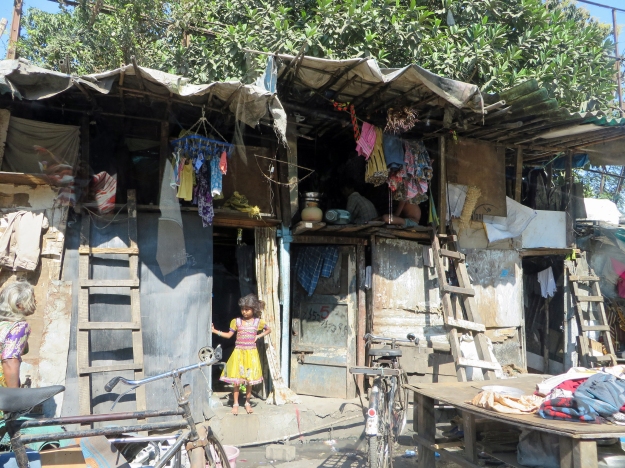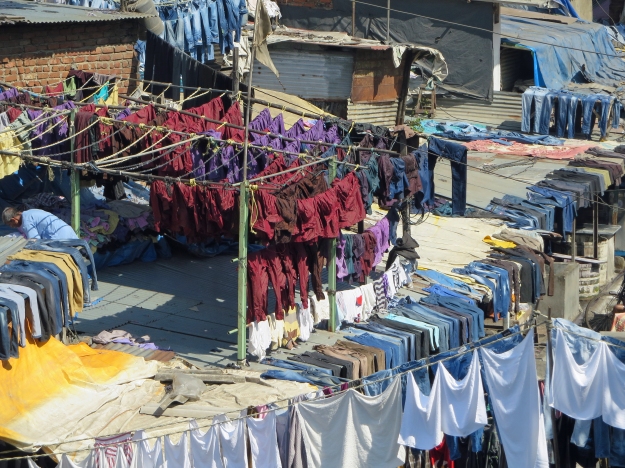At over 16 million residents, Mumbai is India’s largest city. Some see it as a “rite of passage” for travelers to this country. Last week, I spent 5 days there, my first to the city. It was teeming with traffic, touts, and pickpockets, and full of dust and noise. On the chaos scale, I’d put Mumbai right up there with other cities bursting at the seams, where quality of life is sacrificed for growth (Bangkok and Manilla come to mind). When I think of India and rites of passage, I think of half-naked sadhus, colorful Hindu temples, cows and goats and other assorted animals that seem to wander the streets at will, and dusty open spaces where people tend to gather, to sip chai and conduct all kinds of business. I missed seeing these things in Mumbai, and also missed the tuk-tuks. (If you travel very much in Asia, you become very fond of them.)
If you’ve seen Slumdog Millionaire or read Behind the Beautiful Forever by Katherine Boo (highly recommended), “slum” might be the first thing that comes to mind when you think Mumbai. And for good reason. Over half of the city’s population lives in a slum and the trendy thing in the tour business these days is the half-day slum tour ($25). I had a brief excursion into the slums when, on a scenic tour of Mumbai, my driver asked if we could stop at his house in a nearby slum. We drove down street after street, lined with shacks piled one on top of another. Everywhere I looked was an incredible pile of what seemed to me to be junk, but which I imagine can be put to one use or another. On the street, children were playing; people were going about their daily business: taking baths, getting hair cuts, cooking, sleeping. Ravishan brought his aunt and mother out to the car to prove to them that his “international boss” was a woman. Unsmiling, they examined me from head to toe and back again, and finally bobbled their heads from side to side. I assume that means I passed muster.
Many slum neighborhoods sit in the shadows of high rise office buildings and apartments. One controversial building that has attracted lots of criticism is Antilia, the 400,000 sq. ft. home of India’s richest man, Mukesh Albani. Built at an estimated cost of $1 billion (it is the most expensive house in the world), the 47-story building boasts 3 helipads, a temple, two-story recreation room, and theatre. It requires a staff of 600 but it is said the kids still clean their own rooms when home from college. This is in stark contrast, of course, to the kids you see sleeping on the bare concrete with simply a sheet for covering. Mumbai is a city that makes you count your own blessings, wonder what you did to deserve them, and think hard about your social responsibility in a world where there is such a vast divide between those who have and those who do not. In fact, the whole of India encourages internal moral and philosophical dialogues of this sort…I think that is what draws many of us to this country.
If you have clothes laundered while in Mumbai, they are likely to be washed at the Mahalakshmi Dhobi Ghat. Ravishan pointed out the different colors for hospitals, hotels and other businesses. Notice that there’s a separate area for blue jeans, too.
I took the ferry over to Elephanta Island to see the 8th century caves featuring massive carved Shiva sculptures.
The island was crowded with families and school children on tour. In between snapping photos of the carvings, I posed for lots and lots of pictures — and sometimes they want to capture the shot on your camera too. That’s definitely one thing you’ll have to get used to while traveling in India..
A good telephoto lens is a necessity in India. You can get some terrific candid shots.
After a few days in Mumbai, I took a short flight to Hyderabad, to stay at Dr. Raju’s Family Clinic. In my next post, I’ll share some information about my experiences with panchakarma, India’s ancient system of medicine.




















